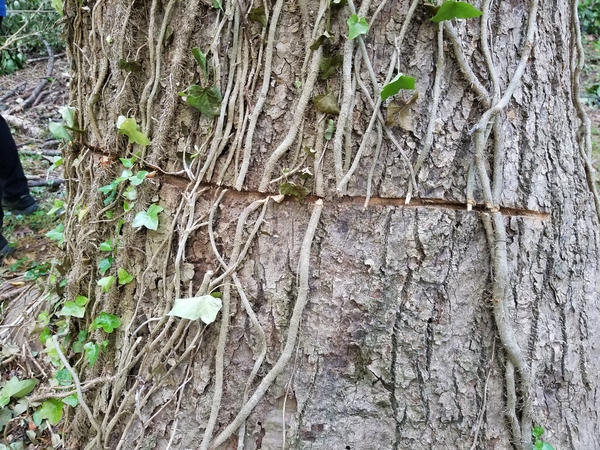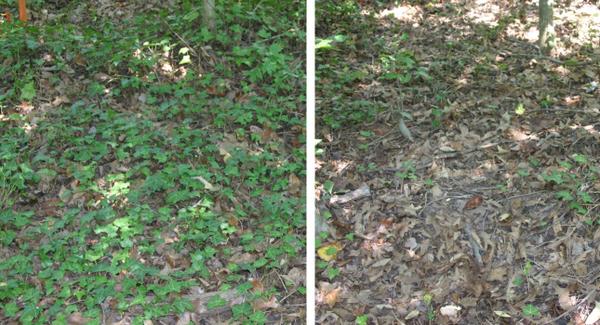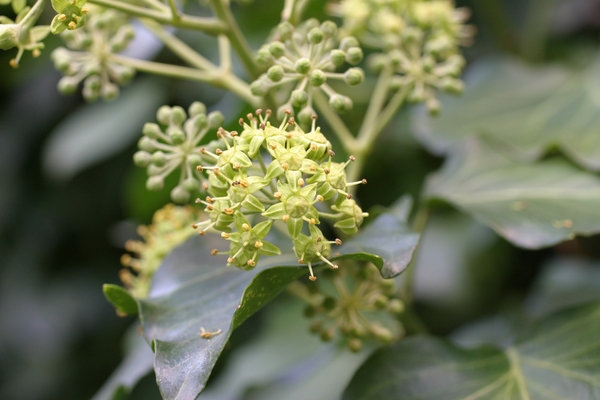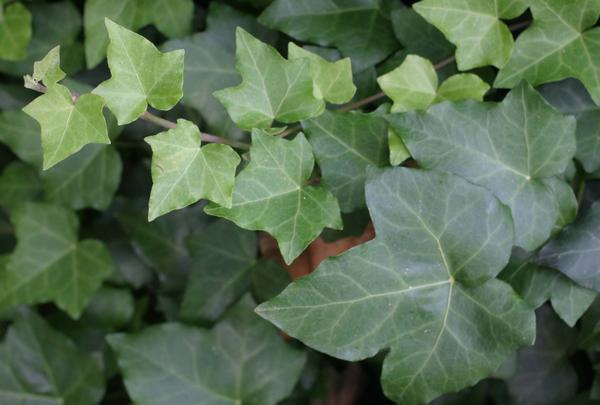Introduction
English ivy (Hedera helix) is a shade-tolerant, woody perennial vine. When established it creates a dense ground cover with attractive dark green foliage. But, left un-checked this introduced plant invades woodlands, climbs (and kills) trees and is considered an invasive species. Pursuing the internet you can find several “recommendations” for controlling English Ivy. Some good, some are questionable.
Non-chemical control
Culturally, this plant is difficult to control.
- English ivy can be controlled with mowing. But the mowing must be frequent (like mowing a lawn) and you must mow the entire infestation to “starve-out” the plants.
- Pull it up. There are several on-line videos demonstrating how to “roll up” the English ivy vines. Cutting the vines into sections, and then cutting the vines where attached to the roots. This will be a very labor-intensive effort. But, if you put enough effort and hours into it, most any weed can be removed by hand. Many vines will grow back from the roots, so return to the site regularly to remove re-growth.
- Remove it from the trees. English ivy in trees can be killed by cutting the stems at the ground and removing the vines from the tree as high as you can easily reach. The remaining vines in the tree will die and eventually fall off.

Cut stems that are climbing trees. The upper vines will die. BUT, be careful not to damage your trees (as shown here)
J. Neal CC BY-NC 2.0
What about herbicides?
If you look on-line you will find many reports and recommendations – some good, some not so good. One of the most commonly recommended herbicide treatments is triclopyr. But, in my experience triclopyr is less effective than glyphosate. What does the research show?
The most effective treatment I have tested is glyphosate applied in the spring. Other 'woody weed control' products were less effective. In particular, triclopyr is a common ingredient in 'woody weed' control herbicide products. We tested triclopyr and found it to be significantly less effective commpared to glyphosate. Dr. Jeff Derr of Virginia Tech reported two applications of 2,4-D amine at 1 lbai/A to actively growing English ivy provided complete control. Dr. Derr also observed that triclopyr was less effective compared to glyphosate or 2,4-D. In contrast, Yang reported 2,4-D to be less effective than glyphosate. All things considered, glyphosate does appear to be the most consistently effective herbicide tested.
1. Timing makes a difference.
For best results, apply glyphosate in the spring when English ivy has 2 to 4 new leaves. Retreat about 6 weeks later if you see re-growth. English ivy becomes less and less susceptible to glyphosate as the season progresses. Control in mid-summer can be improved by mowing the ivy, then spraying the regrowth.
2. The formulation does matter.
All our research was done with the Roundup® branded formulations. You will likely get poorer control with “generic” formulations of glyphosate. Also, rapid-action formulations containing pelargonic acid or diquat can reduce the effectiveness of glyphosate by damaging the leaves before the glyphosate can translocate. Weed control will be poorer if you burn the leaves off before the herbicide can move to the stems and roots. Diluted, ready-to-use formulations will be less effective. Purchase a formulation that is >41% active ingredient and dilute it for treatment (see dosing guideline below).
Look for a formulation that contains only glyphoste as the active ingredient. In retail centers, this is not an easy task. Many herbicide products that used to contain glyphosate have switched to other active ingredients. For example: most formulations of Roundup® sold in retail centers no longer contain glyphosate.
3. There is a clear dose response.
Glyphosate applied at 4 lb ai/A is much better than glyphosate applied at 2 lb /A. See photos below from our 2009 experiment. If you want to kill English ivy, use the higher dose (4 lbai/A) of glyphosate. For the common 41% active ingredient formulation, I recommend a 4% solution by volume (that’s 5.1 ounces of herbicide in one gallon of spray mix). If you get the 51% formulation, you can decrease the concentration to 3% by volume in water (3.8 oz per one gallon of spray mix). The addition of surfactant may help, but is not necessary.

Glyphosate at 4 lb/A (Right) worked better than 2 lb/A (Left) - treated in spring, photo in August 2009
J. Neal CC BY 4.0
Keep it from returning
Regardless of the control method chosen, this is a woody perennial vine that can return from small stem segments. It is also spread by seed. So, return to the site frequently to remove any newly emerged ivy plants. With persistence you can get rid of this pesky weed.
References
Derr, J. (1993) English ivy repsonse to postemergence herbicides. J. Environ. Hort. 11(2):45-48
Neal, J.C. and Skroch, W.A. (1985) Effects of timing and rate of glyphosate application on toxicity to selected woody ornamentals. J. Amer. Soc. Hort. Sci. 110:860-864
Yang Q, Wehtje G, Gilliam CH, McElroy JS, Sibley JL. (2013) English Ivy (Hedera helix) Control with Postemergence-Applied Herbicides. Invasive Plant Science and Management. 6(3):411-415. doi:10.1614/IPSM-D-13-00009.1
Publication date: March 5, 2019
Reviewed/Revised: April 4, 2024
Recommendations for the use of agricultural chemicals are included in this publication as a convenience to the reader. The use of brand names and any mention or listing of commercial products or services in this publication does not imply endorsement by NC State University or N.C. A&T State University nor discrimination against similar products or services not mentioned. Individuals who use agricultural chemicals are responsible for ensuring that the intended use complies with current regulations and conforms to the product label. Be sure to obtain current information about usage regulations and examine a current product label before applying any chemical. For assistance, contact your local N.C. Cooperative Extension county center.
N.C. Cooperative Extension prohibits discrimination and harassment regardless of age, color, disability, family and marital status, gender identity, national origin, political beliefs, race, religion, sex (including pregnancy), sexual orientation and veteran status.




